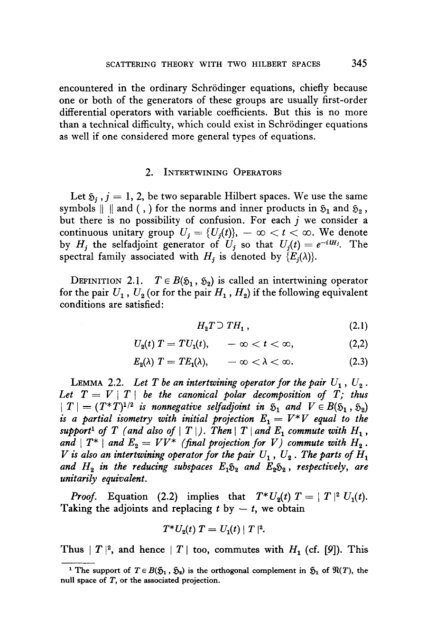On the Characters and the Plancherel Formula of Nilpotent Groups ...
On the Characters and the Plancherel Formula of Nilpotent Groups ...
On the Characters and the Plancherel Formula of Nilpotent Groups ...
Create successful ePaper yourself
Turn your PDF publications into a flip-book with our unique Google optimized e-Paper software.
SCATTERING THEORY WITH TWO HILBERT SPACES 345<br />
encountered in <strong>the</strong> ordinary Schrodinger equations, chiefly because<br />
one or both <strong>of</strong> <strong>the</strong> generators <strong>of</strong> <strong>the</strong>se groups are usually first-order<br />
differential operators with variable coefficients. But this is no more<br />
than a technical difficulty, which could exist in Schrodinger equations<br />
as well if one considered more general types <strong>of</strong> equations.<br />
2. INTERTWINING OPERATORS<br />
Let .sj, , j = 1, 2, be two separable Hilbert spaces. We use <strong>the</strong> same<br />
symbols 11 11 <strong>and</strong> ( , ) for <strong>the</strong> norms <strong>and</strong> inner products in Z& <strong>and</strong> g2 ,<br />
but <strong>the</strong>re is no possibility <strong>of</strong> confusion. For each j we consider a<br />
continuous unitary group U, = (Uj(t)), - CO < t < co. We denote<br />
by Hj <strong>the</strong> selfadjoint generator <strong>of</strong> Ui so that Uj(t) = e-iM*. The<br />
spectral family associated with Hi is denoted by {E,(X)).<br />
DEFINITION 2.1. T E I?(&, s2) is called an intertwining operator<br />
for <strong>the</strong> pair U, , U, (or for <strong>the</strong> pair HI , Hz) if <strong>the</strong> following equivalent<br />
conditions are satisfied:<br />
H,TI TH, , (2-l)<br />
b(t) T = TU,(t), -co

















